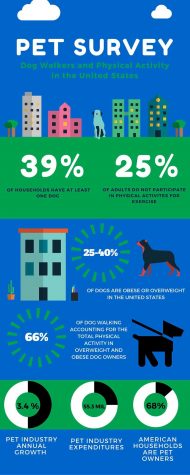Walking dogs is no walk in the park
Dog-walking business presents challenges and opportunities.
Louie stands ready to be taken out for a walk.
Since the dawn of time, dogs have been man’s best friend. As they have provided humanity companionship, affection and even protection, we have in turn cared for our four-legged friends by providing them the basic needs for a comfortable life. One of these needs include taking our dogs out for a walk.
I’ve had my dog, Charlie, for two years already and in that length of time, I was faced with a dilemma. Being a high school senior is mainly time consuming, a fact that I realized impacted my dog more than it did me. When I became too busy to take Charlie out in the outside world for a simple walk, I wondered if I was doing his adventurous, energetic self a disservice and if other dog owners in my area had the same problem.
In 2011, researchers at the Michigan State University examined the differences between those who walk their dogs and those who didn’t. The university studied the exercise routines of 5,900 people in Michigan, including 2,170 who owned dogs, and they found that only two-thirds of dog owners actually walked their dogs. About 40 percent of those who didn’t regularly walk their dogs justified their reasoning by saying their pets didn’t need walking since they would be running around in the yard. Eleven percent, however, hired dog walkers.
Similarly, my neighborhood has many dog owners, and half of these dogs are almost always cooped up in the house or barred from their environment with a fence. Seeing this frequently, I decided to try my hand at a dog walking business. If others were facing the difficulty of fitting in dog walks into their busy schedule, then a dog walking business would be beneficial to both owner and pet. On average, dog walkers are paid $10-$30 per dog, depending on the amount of dogs the person walks, for how long, and if the dog walker is independent or belongs to a dog walking business of sorts. However, I decided to walk dogs for free, a fact that my clients liked. And though dog walking seems to be an easy job, there are qualifications that pet owners look for when hiring a dog walker. Obviously, to be a good dog walker, you need to have experience handling or walking dogs while also retaining knowledge on how to deal with any behavioral issues with the dog or other dogs that your dog comes into contact with. Luckily for me, I met all those qualifications.
I started by creating a flyer for what I wanted to do and handing them out around my neighborhood, hoping someone would call my number on the flyer. Before I did this, I had to research dog walking to see what the business was like in the first place — if there was a growing demand like I thought or not.
Most pet servicing and dog walking businesses catering to the Glendale and La Crescenta area are found online where clients can choose from the provided dog walkers and also let these walkers know what kind of care their pets need, such as overnight stays or longer walks. Rover is one of these online pet servicing businesses. Rover connects pet owners with dozens of trained and experienced dog sitters and walkers by giving them a set of options to choose from such as the days owners want the service, for how long, and how many walks a day are needed.

Miro Minasian, my neighbor, was one of those pet owners who needed assistance. Minasian was my first client and my first opportunity to experience walking other people’s dogs. “It’s great to have someone take care of my dog when I don’t have the chance to,” Minasian said. Minasian has a German Shepherd and Labrador mixed dog named Rocky. Due to Rocky’s breeding, he has grown to his full size and strength quickly, making it increasingly difficult to walk him. “It’s more like he’s walking you rather than the other way around,” Minasian said.
I volunteered my services to Minasian because the difficulty in taking Rocky out for some exercise plus the busy schedule Minasian has limited Rocky’s walking time. During the evening when Minasian would be busy with work, I took Rocky, along with my own dog, out for a walk around the neighborhood for approximately 40 minutes. Rocky was a temperamental dog. He wasn’t the type to take it slow, even though my dog was, which made things a bit difficult. However, it was worthwhile because walking him not only gave Minasian a break to focus on his work, but it also helped me learn how to handle problem pullers like Rocky and how to properly train him for this particular exercise.
“Regardless of his size, breed, gender or even his age, he needs physical activity in order to be a balanced, healthy animal,” veterinarian Dr. Karen Becker writes in her article, “Walking Your Dog: How to Do It Well and Why It’s So Important.” In this online article, Dr. Becker describes the different types of techniques used in dog walking and their effects and also the different types of dogs that ca n be difficult when exercising. Rocky was certainly one of the problem pullers, the dogs who pull the walker with all their strength due to overexcitement or aggression. “The message you want to send your pup is pulling on the leash doesn’t accomplish a thing,” Becker writes.
n be difficult when exercising. Rocky was certainly one of the problem pullers, the dogs who pull the walker with all their strength due to overexcitement or aggression. “The message you want to send your pup is pulling on the leash doesn’t accomplish a thing,” Becker writes.
Louie was a different story. Louie is a 12-year-old Maltese who, unlike Rocky, loved to take his time on his walks and quite literally stopped to smell the roses. Due to his age, Louie had already been accustomed to walking, so the only problems I encountered was when he would take frequent stops to examine the world around him.
What also made things easier with Louie was his preparedness. Louie loved to walk so when the leash was brought out, he obediently and masterfully put his head through it and lifted his paw to where it’s supposed
to go for the harness. “He’s really well behaved so since he’s not pushing me to take him outside all the time, I forget to make time for it,” Louie’s owner Angela Aschian said. Aschian spends long hours at the Keck Hospital of USC where she works as a project manager. “It’s a relief having someone give Louie the exercise he needs when I’m not there because he’s an old dog, good health is crucial,” Aschian said.
Walking these dogs not only gave their owners a break, but it also improve d my health as well. Like Aschian and Minasian, I wasn’t taking enough time to go out and participate in this kind of exercise as well. However, since I started walking their dogs, I became more active and fell into a routine of regularly walking to keep in shape. In the United States, an intervention study explored the correlation between exercise and owning pets and found that dog-related activity, such as walking dogs, accounted for about two-thirds of the total physical activity in overweight dog owners. Studies have shown that the regular exercise that walking dogs provides reduces chances of illnesses such as heart disease, diabetes, and cancer in pet owners while at the same time ensuring their dogs stay in good physical condition as well.
Simultaneously, walking these dogs when they usually stay indoors, contributed to their happiness. Exercising with dogs serves to strengthen the bond between owner and pet and also lets them explore their surroundings and experience some freedom. The more time I spent with these dogs and researching the business itself, it started to dawn on me that dog walking has become a growing demand among the public, a business and pleasure all rolled into one.

INTERESTS/HOBBIES: Writing stories, reading books, and cooking
EXTRACURRICULAR ACTIVITIES: Playing guitar
THREE WORDS TO DESCRIBE ME ARE: Loud,...













